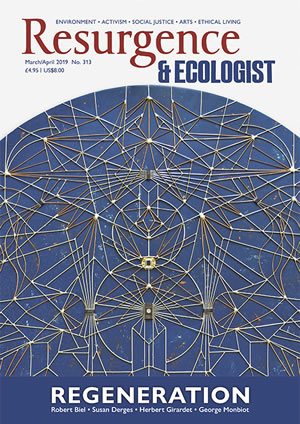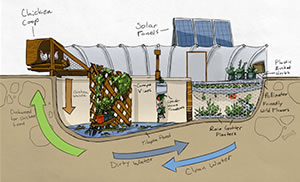The tendency towards decay (known as entropy) destroys order and reduces everything to randomness. But a system can create order, if there’s a flow running through it. This happens with the Earth: solar energy enters in, and the Earth sheds (‘dissipates’) waste heat into space. Individual animals and plants do this too; and, taking the Earth system as a whole, the waste excreted by one component is absorbed into another, with the result that the flows are ‘tucked in’. As James Lovelock says, the pollution of one is the meat of another.
When we build or manufacture things that don’t exist in Nature, the bad tendency has been to neglect the tucked-in loops, so there’s simply a lot of energy and scarce matter flowing into each process, and a degraded form of these is pumped out in the form of garbage, pollution and greenhouse gases. But we can address this problem by introducing a circular-systems approach. A good example is industrial ecology (or industrial symbiosis), where many productive processes are networked, the waste of one becoming “the meat of another”.
My own work is to do with food systems, and in fact there’s always a food-growing component in industrial ecology, because urban farms can absorb a lot of by-products: grey water, surplus heat (which could warm greenhouses), and compostable waste (such as hops from breweries). This is one reason why urban farming is potentially more productive than rural farming, and contributes to an ‘urban metabolism’, characterised (like the body’s metabolism) by flows and circulation. I participated in a project as part of University College London, setting up an anaerobic digester: a bicycle-driven box collects waste from local restaurants, and the composting process reduces it to digestate and methane gas. Food is then grown using the digestate as fertiliser and cooked using the gas, and we serve it in the project’s café – so the loop is closed.
These experiments are really interesting, but we should also think critically about what we are trying to achieve, and how. Thus, in industrial ecology, we shouldn’t let the food sector be treated merely as a sink for whatever industry wants to get rid of; at the very least, let’s insist on defining its role in terms of what farming actually needs from the urban metabolism, rather than simply what it can absorb.
Also, in a broader sense, it’s a lazy solution to merely give crops a lot of inputs, because this inhibits plants’ abilities to strengthen themselves. In some amazing experiments, French peasant Pascal Poot deliberately lets his crops fend for themselves in the harshest conditions, and they develop a heritable capacity to cope. The scientific explanation has to do with which genes are ‘expressed’ (switched on): if the plant doesn’t need them, they stay dormant! Also, applying fertiliser high in nitrogen – as tends to be the case with digestate from anaerobic composting – may accentuate a major form of pollution, which in turn triggers CO2 emission.
The food issue prompts a further interesting question: if we speak of closed-loop systems, how far is it really desirable to be closed?
It’s an exciting challenge to be self-reliant. I’ve found it’s not too difficult to produce all our family’s vegetables on our own plot, while still leaving time to do other jobs. This is achievable because a no-dig (no-till) system minimises inputs of work: by not working the soil, you encourage natural balances to self-engineer, so that fertility is maintained through the free energy of self-organisation. Residues are composted back, and the deep roots of plants like Russian comfrey can replenish minerals from the rocky layer beneath the soil.
But, taken to extremes, self-reliance could lead to a survivalist model where you’re scared of everything collapsing in the world outside. NASA has expressed interest in a swimming pool turned aquaponic farm, in the US.
In a realistic context, however, we are of course entirely dependent on the wider ecosystem within which our farm is inserted, so the ‘closedness’ is merely illusory. And the danger of a survivalist version of closed loop is that we become introspective and cut ourselves off from our place in society. The point is that a farming model of the future must be able to feed the wider population in a sustainable way – which requires a large surplus over and above the consumption of the cultivators themselves.
At the same time, we must hold on to what is correct about self-reliance: instead of obsessing about how to absorb waste, let’s rather think about making our systems so efficient in themselves that they hardly produce any waste; and then the real meaning of ‘efficiency’ becomes ‘maximising the capacity for self-organisation’. Perhaps the slogan we’re looking for is ‘Output lots of food, not lots of entropy’!
Thus, taking as an example a project in France, La Ferme du Bec Hellouin, it’s possible using the methods of agro-ecology to produce a sizeable surplus that can contribute to the wider society – both by marketing the produce and by spreading ecological consciousness.
We don’t yet have all the answers for a sustainable food system, but what is encouraging about today’s debates is that we are raising meaningful questions. For example, the curvy or concentric beds encouraged by agro-ecology or permaculture are intuitively much closer to Nature’s contours; but do they place an upper limit on productivity? This is an interesting question: do we still need to safeguard some mechanisation, and if so, what would it look like?
The recently released film The Guardians, directed by Xavier Beauvois, is set in rural France during the first world war, and offers an extremely interesting exploration of human relations against a background of wider socio-economic shifts. In the early part, labour is very manual and harsh, but also necessarily cooperative, because everyone needs to collaborate. As things develop, farming is organised more as a business; families invest in machinery, productivity is improved, but the solidarity is lost and human relations are sacrificed. So what’s the solution? Of course, the mainstream approach to mechanisation is not sustainable anyway, but is there a different way?
Perhaps part of the answer can be glimpsed in a cooperative designing farm machinery, L’Atelier Paysan. Its principles of organisation are intrinsically commons-based, peer-to-peer and open-source. In this way, it is tapping into a sharing economy, and a more broadly sharing society, where creativity constantly circulates, as part of an iterative process of co-learning. The result is a set of constantly evolving blueprints for a new type of machinery wholly dedicated to serving agro-ecology.
The lesson is that we need a circular system, not just in material flows, but also in flows of innovation and ideas; and this in turn can help galvanise social regeneration.







